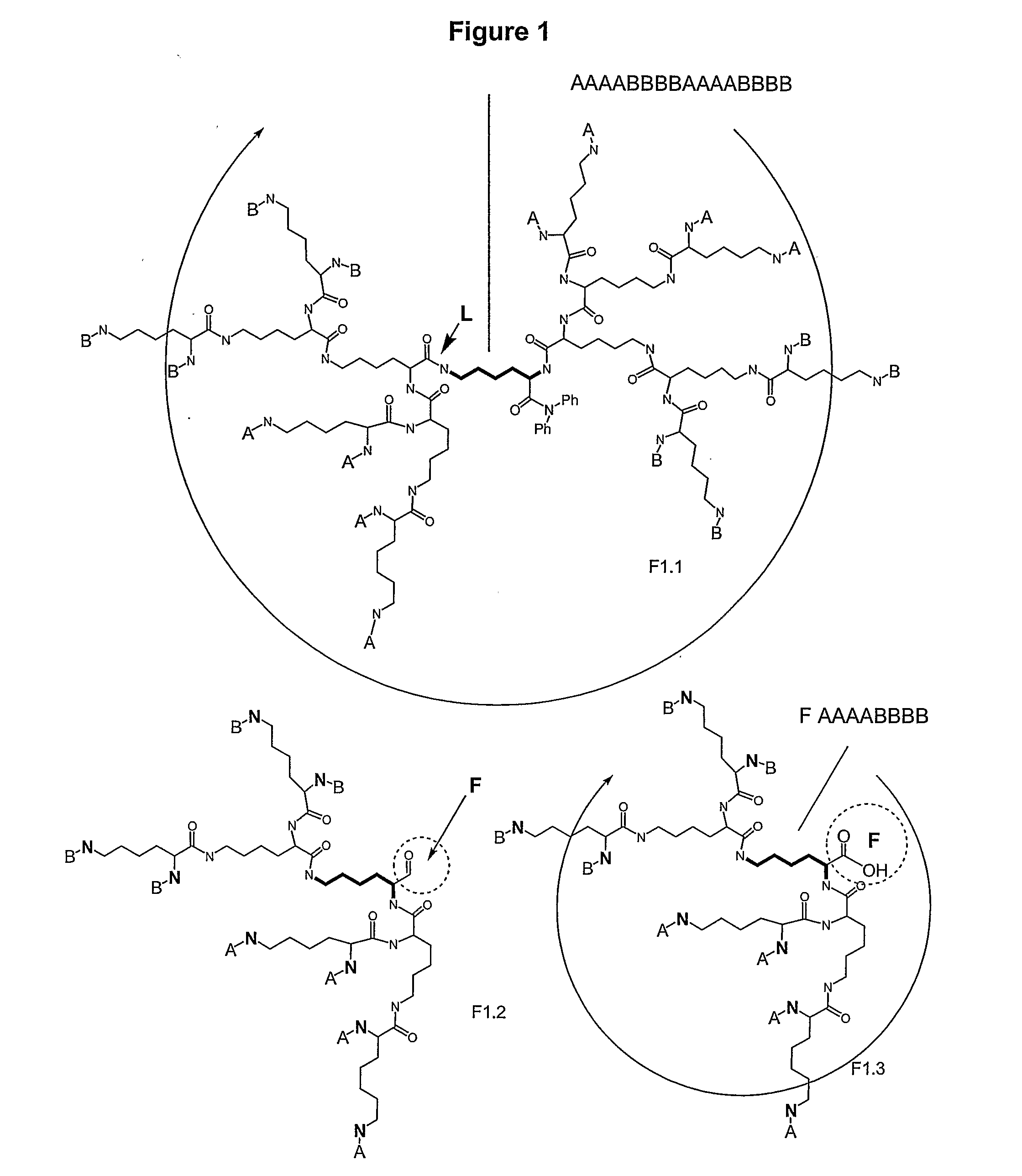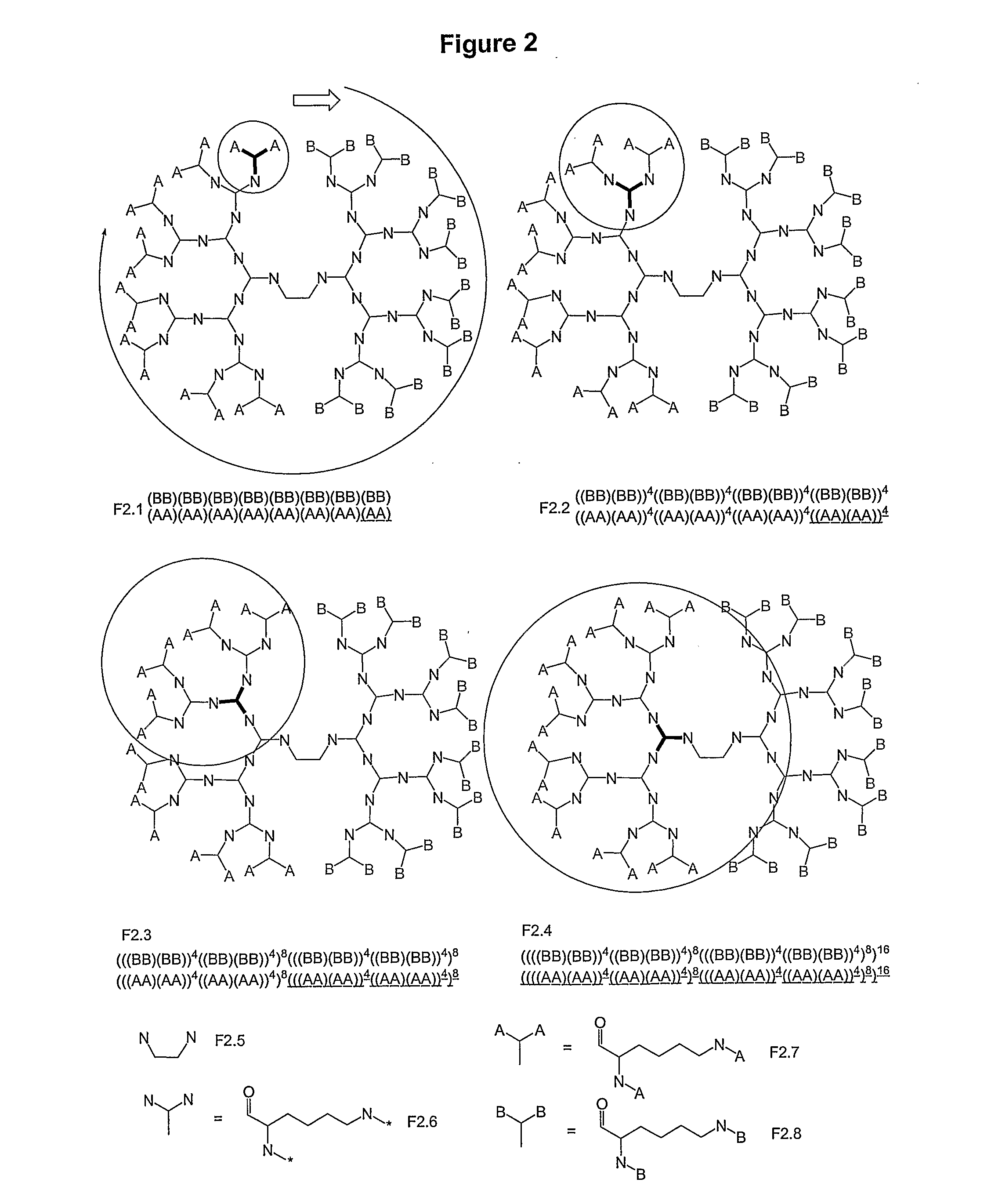Macromolecular Compounds Having Controlled Stoichiometry
a micromolecule and stoichiometry technology, applied in the field of macromolecules, can solve the problems of loss of monodispersity and significant disadvantage in the lack of radial (i.e. surface decoration) monodispersity
- Summary
- Abstract
- Description
- Claims
- Application Information
AI Technical Summary
Benefits of technology
Problems solved by technology
Method used
Image
Examples
example 1
BHALys [Lys]2 [α-Boc]2 [ε-NH2]2
i. BHALys [Lys]2 [α-Boc]2 [ε-CBz]2
[0450]
SurfaceSurface TopologyStoichiometry((Boc CBz)(Boc CBz))42Boc2CBz
[0451]BHALys [NH2.TFA] (200 mg, 0.371 mmol) was dissolved in DMF (2.0 ml) and treated with TEA (258 μl, 1.85 mmol), stirring at ambient temperature and resulting in a clear solution. PNPO-α-Boc-ε-CBz-Lys (446 mg, 0.890 mmol) was added in one portion and the reaction mixture immediately turned bright yellow, and after five minutes all solid matter had dissolved. Stirring was continued for 24 h, then the reaction mixture was poured onto iced water and stirred. This suspension was filtered and the resulting solid pellet was rinsed repeatedly with water. The solid pellet was air-dried, resuspended in ACN, filtered and air-dried to give BHALys [Lys]2 [α-Boc]2 [ε-CBz]2 (343 mg, 89%) as an off-white solid.
[0452]LC / MS (Hydrophobic / TFA): ESI (+ve) m / z=1037.19 [M+H]+; calculated (C57H77N7O11) 1036.29 g / mol. Rf (min)=13.8.
ii. BHALys [Lys]2 [α-Boc]2 [ε-NH2]2
[0...
example 2
BHALys [Lys]4 [α-NH2]4 [ε-Boc]4
i. BHALys [Lys]4 [α-CBz]4 [ε-Boc]4
[0456]
Surface TopologySurface Stoichiometry(((Boc CBz)(Boc CBz))4((Boc CBz)(Boc4BocCBz))4)84CBz
[0457]A solution of BHALys [Lys]2 [NH2.TFA]4 (501 mg, 0.98 mmol), TEA (0.7 ml, 5.02 mmol) and DMF (10 ml) was treated with PNPO-α-CBz-ε-Boc-Lys (1.18 g, 2.35 mmol) following the method described in Example 1.i. The product BHALys [Lys]4 [α-CBz]4 [ε-Boc]4 (830 mg, 84%) was obtained as a colourless solid.
[0458]LC / MS (Phobic / TFA): ESI (+ve) m / z=1009.71 [M+2H] / 2+; calculated C107H153N15O23 2017.48 g / mol. Rf (min)=7.58.
ii. BHALys [Lys]4[α-NH2]4 [ε-Boc]4
[0459]
SurfaceSurface TopologyStoichiometry(((Boc NH2)(Boc NH2))4((Boc NH2)(Boc NH2))4)84Boc4NH2
[0460]To a magnetically stirred solution of BHALys [Lys]4 [α-CBz]4 [ε-Boc]4 (400 mg, 0.3 mmol) and 2,2,2-trifluoroethanol (8 ml) was added 10% Pd / C (203 mg). The black suspension was hydrogenated under standard conditions (Rt, atmospheric pressure) for 19 h. After this time, the suspensio...
example 3
BHALys [Lys]4 [α-Boc]4 [ε-NH2]4
i. BHALys [Lys]4 [α-Boc]4 [ε-CBz]4
[0462]
SurfaceSurface TopologyStoichiometry(((Boc CBz)(Boc CBz))4((Boc CBz)(Boc CBz))4)84Boc4CBz
[0463]A solution of BHALys [Lys]2 [NH2.TFA]4 (503 mg, 0.49 mmol), TEA (0.7 ml, 5.02 mmol) and DMF (10 ml) was treated with PNPO-α-Boc-ε-CBz-Lys (1.18 g, 2.35 mmol). The reaction and product isolation were carried out according to the method described in Example 1.i. The product BHALys [Lys]4 [α-Boc]4 [ε-CBz]4 (875 mg, 88%) was isolated as a colourless solid.
[0464]LC / MS (Phobic / TFA): ESI (+ve) m / z=1009.71 [M+2H] / 2+; calculated C107H153N15O23 2017.48 g / mol. Rf (min)=7.40.
ii. BHALys [Lys]4[α-Boc]4 [ε-NH2]4
[0465]
SurfaceSurface TopologyStoichiometry(((Boc NH2)(Boc NH2))4((Boc NH2)(Boc NH2))4)84Boc4NH2
[0466]A solution of BHALys [Lys]4 [α-Boc]4 [ε-CBz]4 (400 mg, 0.2 mmol) and 2,2,2-trifluoroethanol (8 ml) was added 10% Pd / C (205 mg). The reaction and product isolation were carried out according to the method described in Example 2....
PUM
| Property | Measurement | Unit |
|---|---|---|
| homogenous | aaaaa | aaaaa |
| lipophilic | aaaaa | aaaaa |
| surface | aaaaa | aaaaa |
Abstract
Description
Claims
Application Information
 Login to View More
Login to View More - R&D
- Intellectual Property
- Life Sciences
- Materials
- Tech Scout
- Unparalleled Data Quality
- Higher Quality Content
- 60% Fewer Hallucinations
Browse by: Latest US Patents, China's latest patents, Technical Efficacy Thesaurus, Application Domain, Technology Topic, Popular Technical Reports.
© 2025 PatSnap. All rights reserved.Legal|Privacy policy|Modern Slavery Act Transparency Statement|Sitemap|About US| Contact US: help@patsnap.com



